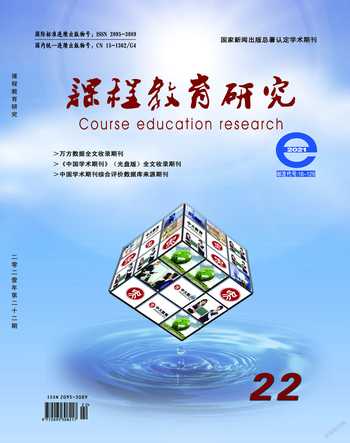高职学生中国传统文化输出教学实践研究
李淑梅
【摘要】“母语文化失语”的现象在高职生身上普遍存在,提高高职生文化软实力和文化输出能力刻不容缓。为解决以上的问题,笔者在商务英语专业的综合英语课上开展我讲好中国成语故事的文化输出教学实践并对教学效果进行了评估,是一次值得推广的文化输出教学尝试。
【关键词】成语故事 教学实践 文化输出
【Abstract】The phenomenon of “mother tongue cultural aphasia” is widespread among higher vocational students. It is urgent to improve the cultural soft power and cultural output competence of higher vocational students. To solve the above problems, the author implement the cultural output teaching practice of telling Chinese idiom stories in English class and measure the effect of this teaching practice, the write think it is a good pilot teaching attempt.
【Keywords】Chinese idiom; teaching practice; culture output
【中圖分类号】H319.3 【文献标识码】A 【文章编号】2095-3089(2021)22-0032-03
一、高职生文化输出的现状
文化输出其本质是传递真实、全面的文化,进而起到文化的传播目的,呈现本国文化之美。
长久以来,专业技能教育培养,是我国高职院校人才培养的重心。部分高职院校过于重视专业技能教育,轻视学生的职业道德和人文素养培养,造成学生出现趋于功利、崇尚享乐、缺乏责任感等问题,文化输出能力不足。中华优秀传统文化中蕴含大量人文智慧,可以对高职院校学生思想认知产生潜移默化的影响,对高职院校素质教育的高水平开展具有重要的积极的影响。
二、中国传统文化输出教学活动设计
在中国文化血脉延续和对外输出中,成语占据了一个制高点。新冠肺炎疫情全球性蔓延,伊朗大使馆微博求助发言写下了好几个中国成语:雪中送炭、滴水之恩、涌泉相报、拳拳盛意、铭感五内。网络热播的电影《囧妈》中,俄罗斯姑娘娜塔莎能随口说出“一丘之貉”,徐铮母子的电影台词里更是用上了一系列的数字成语,着实精彩。成语,是每个中国人都能随手使用的文化,也是每个外国人不明觉厉、喜欢学、学了就爱用的文化。本文以高职生综合英语课程的课前十分钟教学活动为例,进行高职学生中国传统文化输出教学实践的尝试,具体情况如下:
(一)课前任务及要求
每节课4位学生轮流用英语讲述中国迷你成语故事。学生需以历史成语故事为基础,用图文结合表现形式,向观众介绍中华民族悠久的历史、高超的智慧和历久弥新的语言文化,展现成语故事中蕴含着的英雄主义、乐观主义、人道主义等崇高的思想与美德,勤劳、善良、勇敢、团结、忠诚、孝顺、公正、清廉、舍己为人等优秀品质。每人展示时间为3分钟以内,只能使用一幅图来辅助讲解,要求用语简单清晰,通俗易懂,叙述绘声绘色,鼓励使用一些肢体语言,道具,互动来让讲故事的过程更加生动有趣。一个学生一个成语故事,不允许重复。
(二)教学实施过程中问题及教学策略
问题1:语言能力不足和传统文化底蕴不深
讲故事人人都会, 但要讲好一个故事并不容易, 用英语讲故事就更不容易。部分高职生英语基础薄弱,开口难,部分高职生开口就错,部分高职生开口就断,故事说得零零碎碎,磕磕巴巴。通过测试和访谈,探究其原因,一方面是语言基础确实有所欠缺,另一方面是学生的学习动机、学习态度、学习方法上有问题。有的学生把讲故事只当作作业,应付了事。有的学生就只是简单的把找到的成语故事,百度机翻一下,整个语言生硬。
教学策略:
针对以上问题,课程教师提出下列教学策略:(1)要求所有学生在上台讲英文故事之前,至少预演故事三遍,并邀请3位同学观摩提出相应的修改意见,其故事文稿须提前交至老师予以修改;(2)鼓励学生选择一些网络上有成熟英文视频故事进行跟读,复演,打磨;(3)鼓励学生对成语进行创意的改编和简化,以利于听众能听懂明白;下面是学生提供的成语英文故事文稿和教师的修改稿案例:
学生文稿1 :
Long time ago, there was a man named Mengzi. His mother moved three times for his growth. For the first time, they moved to the near of grave, here, Mengzi learned how to pray for the dead people, his mother thought the environment was bad, so they moved again, this time their home was near the shops, here mengzi learned how to bargain, his mother was disappointed, so they moved for the third time, this time, their home was next to the school, Mengzi was interested in the what teacher said and learned practical knowledge. His mother was happy because the environment can help him to become a useful person.
教师修改稿1:
孟母三迁(Mother Meng moved home three times)
Long time ago, there was a man named Mencius. His mother moved three times for his growth. For the first time, they moved to the place near to grave where Mencius learned how to pray for the dead people, Mother Meng thought, “This is not the place I would like to raise my son.” so they moved second time, this time their home was near to marketplaces, where Mencius learned how to bargain, his mother was disappointed.
“This is not the place I would like to raise my son, either” said his mother so they moved for the third time, this time their home was next to the school, Mencius was interested in the what teacher said and acquire practical knowledge. His mother was happy said,“This is the place where my son should live from now on.”because the environment can help him to become a useful person.
学生文稿2:
走马观花(look at the flowers while riding a horse/get a passing glance at) Mengjiao, a poet of the Tang Dynasty, lived in a poor life.With the encouragement of his mother,he went to Beijing many times and failed to pass the exam. He didnt get a scholar until he was 46. He expressed his joy by writing a poem “A days view Changan flowers is full of complacency and horseshoes disease.”
唐朝诗人孟郊年轻时隐居嵩山,过着清贫闲淡的生活,在母亲的鼓励下,他多次进京赶考没有考中,直到46岁时才考取进士,他用写诗“昔日龌龊不足夸,今朝放荡思无涯。春风得意马蹄疾,一日看尽长安花”来抒发自己的喜悦心情。原形容事情如意,心境愉快。后多指大略地观察一下。比喻观察事物或了解情况不深入细致。
教师修改稿2:
Mengjiao, a poet of the Tang Dynasty, lived in a poor life. With the encouragement of his mother, he went to the capital and take national examination to get scholar title from the government.Unluckily he has failed to pass the exam so many times. Finally he has made it and won the scholar title (JinShi) when he is 46, so he could get a job in the government.
He wrote the poem to show his joy. The last two sentences said:“It seems that the horse ran so much faster at this happy moment that I can tour around beautiful sights of Changan (Xian ) in one day.”
从上面2稿的对比,我们看出学生能有创意的改编简化故事,但是由于自身古文学修养的不足,导致有时讲出来的故事不能很好地再现古代文化,如孟子和孟母的译法,古诗和古代科举进士的译法,作为老师可以补充一些古文的专业翻译技巧和传译技巧。
问题2:故事讲述风格不自然
经过预演后,大部分同学可以比较流畅地讲述故事,但部分同学公众发言经验少,对自己的英语语言功底不自信,很少有同学能够在讲述故事的过程中,展开一些与听众的互动。
教学策略:
針对以上问题,课程教师提出下列教学策略:(1)要求听众在故事完成后提出一个小问题,锻炼生生互动;(2)建议学生结合图片讲故事,能利用图片来突出故事的点;(3)鼓励学生注意使用一些手势语言和面部语言,让故事能有形有神;(4)在学生故事讲完后,给学生相应的奖励和建议卡片,帮助其树立自信心。
问题3:故事讲述过于复杂
部分同学故事改编能力不强,导致简单故事,用词复杂,教师通过小组合作的方式,鼓励学生互相帮助简化故事,增加故事的易读性。下面就是一个成语故事语言简化案例:
改编前的学生文稿:
One morning he found a hole in the sheepfold. The Wolf went into the hole and carried off a sheep. The neighbors suggested that he repair the sheepfold. He was unmoved. The next day he lost another sheep and regretted not having listened to their advice. Then he went to repair the hole and never lost another sheep again. The story is losing the sheep, mending the sheepfold, and the rest of the sheep wont be lost. When errors occur, they can be corrected immediately to reduce errors. If problems are identified in time and remedial action is taken, continuing losses can be avoided.
小组简化后文稿:
One morning the sheep owner found out one sheep is missing in the sheep house. The neighbors said, “Look, here is a big hole. It must be the wolf came through this role and took your sheep away. You should repair the hole now”. But the sheep owner didnt take his neighbors advice. The next day he lost an sheep again! This time he changed the mind and covered the hole. From then on ,no more sheep was stolen by the wolf. This story tell us it is never too late to mend.
(三)课后的巩固与强化
为了固化学生讲故事的成果,课后教师要求学生以小组为单位,利用视频制作软件,选取一个故事,用图片、字幕、配音制作一个英文成语故事视频,可以发布于新媒体,进行投票比赛,并奖励最优秀的作品。
三、中国传统文化输出教学实践效果与反馈
课后,100%同学完成了英文成语故事的讲述,95%的同学完成了英文成语故事视频,大家觉得成就感很大,不但深化对我国传统文化的理解和表达,古代文化中的一些伦理智慧对他们人生观、世界观、价值观也带来积极的影响,更是一次有意思的跨文化传播的有趣尝试。
参考文献:
[1]刘佳莹.中国文化英语在高职生人文素质教育中的必要性[J].考试与评价(大学英语教研版),2016(2):106-110.
[2]韓岳彤.高职服务类院校文化建设与人才输出[J].现代妇女(下旬),2014(5):197.
[3]王美华.外国留学生文化课程的思政导向与教学方法——以“寓言与成语故事”课程为例[J].黑龙江生态工程职业学院学报,2021,34(1):137-139.

